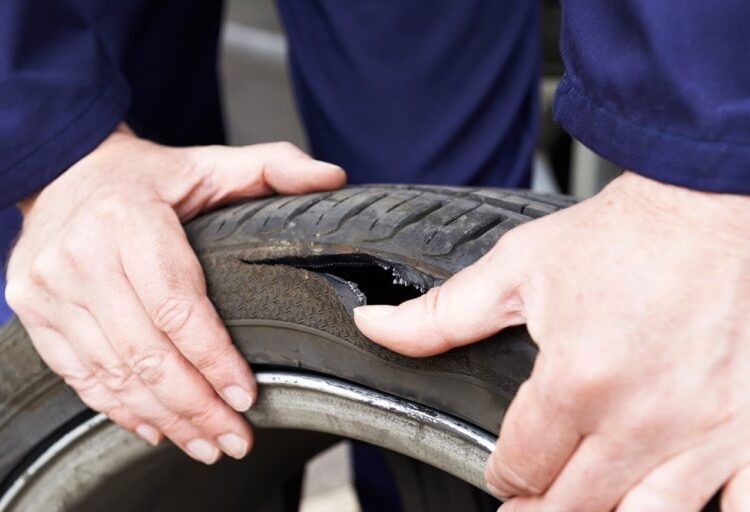A tire blowout on the highway is a sudden and terrifying event that can have widespread consequences, not only for the driver but for everyone nearby. The sheer force of a blowout can instantly throw a vehicle out of control, often leading to dangerous situations in high-speed traffic. Understanding how these incidents unfold and what you can do to protect yourself is critical for highway safety.
The unpredictability of a blowout leaves little room for error, making preparedness essential. The impact of a tire failure can extend far beyond the immediate danger, affecting traffic patterns and even road infrastructure. Exploring the ripple effects of a tire blowout reveals just how serious these accidents can be.
How Tire Blowouts Lead to Traffic Congestion?
A tire blowout does more than just put the affected vehicle at risk; it can disrupt traffic flow for miles. The sudden need to stop or swerve creates a ripple effect, causing cars behind to brake abruptly. This can lead to secondary accidents, traffic congestion, and delays that last for hours.
Emergency responders often have to deal with the aftermath, managing both the crash site and the ensuing traffic jam. In some cases, lanes may need to be closed entirely to remove debris and damaged vehicles safely. These disruptions have economic implications, too, as they delay deliveries and increase fuel consumption for drivers stuck in traffic.
Impact on Road Infrastructure
Tire blowouts can also have a lasting impact on road infrastructure. Shredded tire pieces and rubber debris scatter across lanes, potentially damaging the road surface. The high force of heavy vehicles losing a tire can even create potholes or cracks in the asphalt, making highways more hazardous for all drivers.
Maintenance crews must work quickly to repair the damage and clear debris, sometimes requiring lane closures and detours. These repairs can be costly, and frequent blowouts on the same stretches of road can accelerate wear and tear. Infrastructure damage not only affects safety but also drains public resources, highlighting the need for proactive measures to prevent tire failures.
The Dangers of Multi-Vehicle Blowouts
When multiple vehicles experience tire blowouts simultaneously, the danger multiplies exponentially. Factors like heatwaves, poor road conditions, or even construction debris can cause tires to fail in clusters. A multi-vehicle blowout event can create a catastrophic situation, with cars and trucks careening into each other at high speeds.
The chaos of a multi-vehicle incident often overwhelms even the most experienced drivers, making evasive maneuvers nearly impossible. Emergency responders face significant challenges in securing the scene and providing aid, especially if there are numerous injured parties. Understanding the unique risks of these situations underscores the importance of tire safety for all drivers.
Commercial Vehicles: An Added Layer of Risk
Tire blowouts in commercial vehicles, such as delivery trucks and 18-wheelers, present an added layer of risk. The size and weight of these vehicles make them especially dangerous when control is lost. A truck with a blown tire may jackknife, tip over, or spill its cargo, creating even more hazards on the road.
Fleet managers must prioritize regular tire maintenance to prevent these catastrophic outcomes. The legal implications can also be severe, especially if the blowout is linked to negligence in vehicle upkeep. Victims injured by these incidents may seek the help of a tire blowout attorney to navigate the complexities of liability and compensation.
The Science Behind Tire Wear and Tear
Understanding the science of how tires wear down can help drivers and fleet managers make smarter decisions about maintenance. Tires are subjected to immense friction, heat, and pressure as they roll along roadways, causing gradual degradation of the rubber and structural components. Factors such as tire composition, road surface texture, and driving habits all play a role in how quickly a tire deteriorates.
For example, aggressive driving behaviors, like hard braking and rapid acceleration, increase tire wear significantly. Additionally, road surfaces with rough textures, such as gravel or poorly maintained asphalt, can cause tires to wear out faster compared to smoother highways. Knowledge of these scientific principles allows drivers to better understand tire health and take steps to maximize their lifespan.
Environmental and Ecological Consequences
Beyond the immediate danger to human life, tire blowouts can also have environmental consequences. Shredded tire debris often ends up scattered along highways, eventually breaking down into microplastics that contaminate soil and waterways. The chemicals used in tire manufacturing can leach into the environment, posing risks to wildlife and ecosystems.
Efforts to clean up this debris are necessary but resource-intensive. In some regions, tire fragments contribute to pollution levels that affect local flora and fauna. Addressing the environmental impact of tire blowouts highlights the importance of sustainable tire manufacturing and proper disposal practices.
The Mental Health Effects of Being Involved in or Witnessing an Accident
The psychological impact of witnessing or being involved in a tire blowout can be profound. Drivers who narrowly escape a blowout incident may develop a fear of highway driving or experience anxiety when traveling at high speeds. Passengers and even witnesses to such events can also suffer from emotional distress, requiring therapy or counseling to recover fully.
Recognizing and addressing this trauma is essential for thorough recovery. Mental health support is equally vital as physical rehabilitation for those impacted. Sharing experiences and seeking assistance enables victims to start healing and rebuild their confidence during recovery.
Advances in Tire Safety Technology
The future of tire safety lies in technological advancements designed to minimize the risk of blowouts. Innovations such as self-sealing tires, pressure monitoring systems, and advanced rubber compounds are making vehicles safer. These technologies can alert drivers to potential issues before a tire fails, allowing for preventive action.
Automated driving systems and smart highways could further reduce the likelihood of blowout-related accidents. As these advancements become more widespread, the hope is that tire blowouts will become a rarer occurrence. Until then, staying informed and vigilant about tire maintenance remains the best defense against these dangerous incidents.




